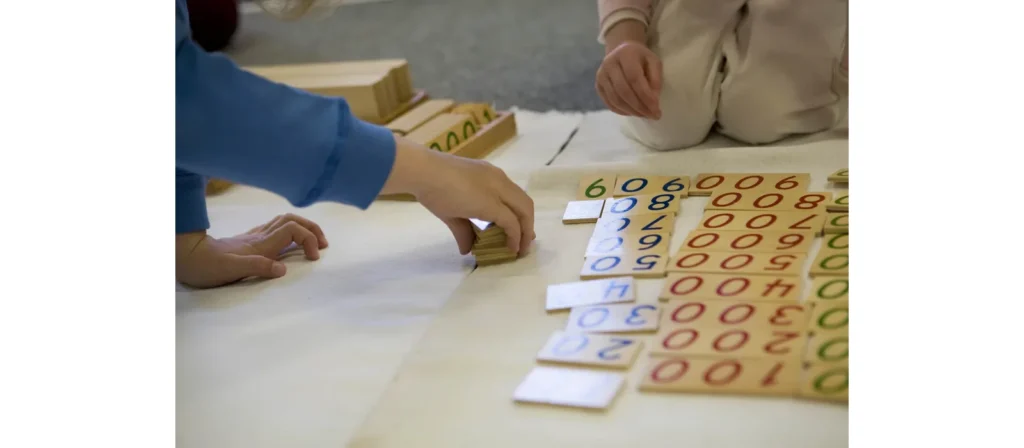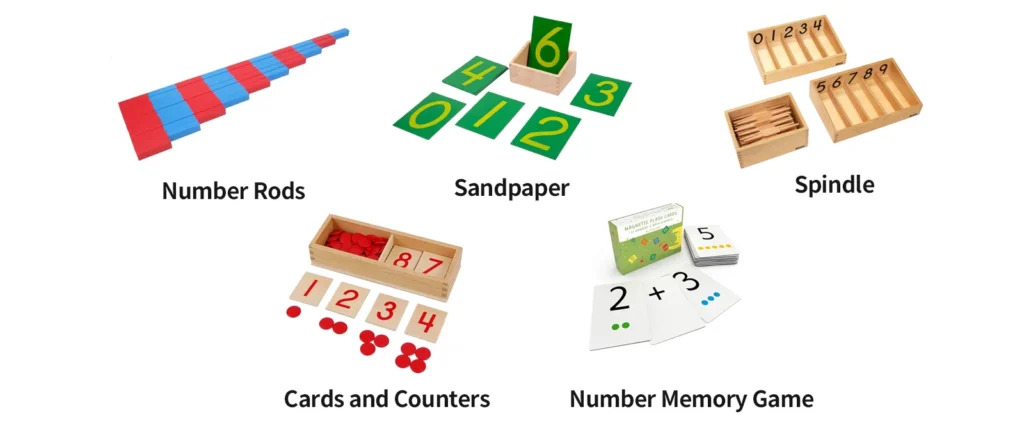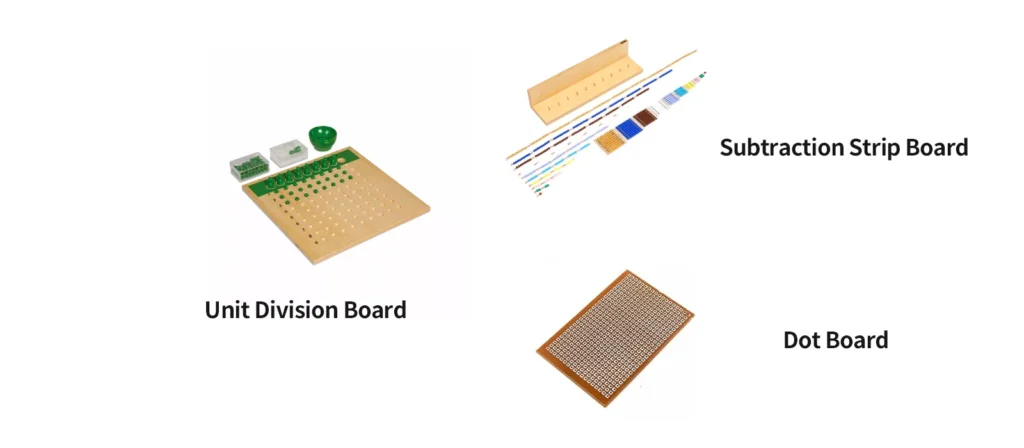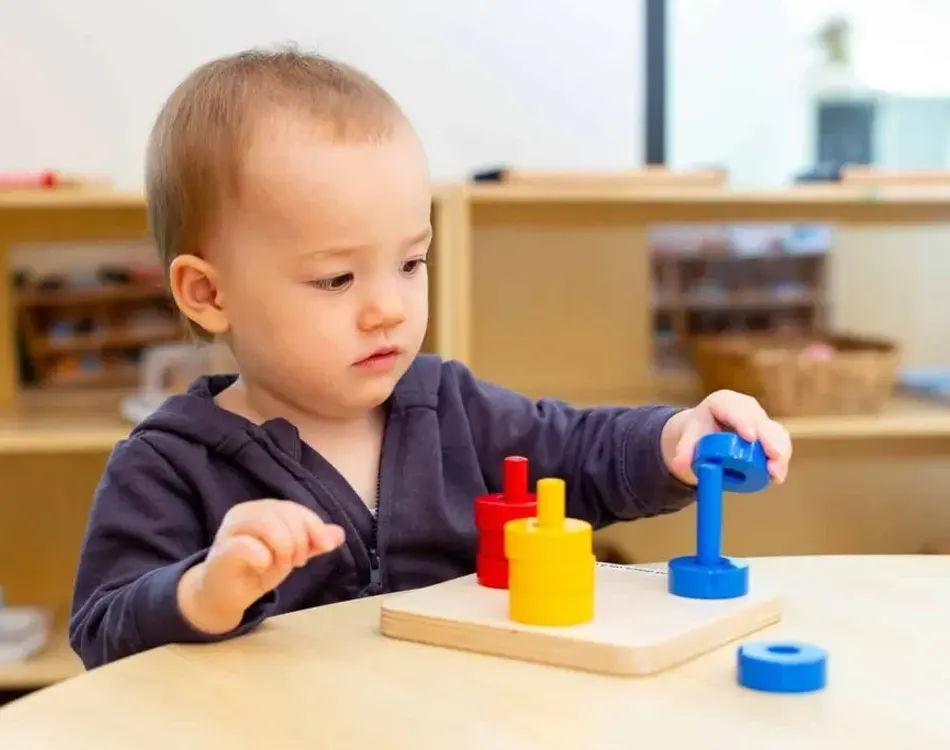Have you ever wondered why some children seem to grasp math concepts effortlessly while others struggle to connect numbers with meaning? How can early educators make abstract ideas like quantity, order, and value come alive for young minds?
That’s where Montessori Math Materials come in. Built on the philosophy that children learn best through hands-on exploration, these thoughtfully designed tools turn complex math ideas into concrete experiences. Instead of simply counting on paper, children feel quantities through beads, rods, and number boards, bridging the gap between the physical and the abstract. For educators and parents alike, understanding how these materials work can transform the way math is introduced, making it not only accessible but truly enjoyable.
In this article, we will dive deep into the world of Montessori Math Materials, unpacking how they support early learners, empower educators, and lay a lifelong foundation for mathematical confidence and curiosity.

What Are Montessori Math Materials?
Montessori math materials are purpose built, hands on learning tools that turn abstract ideas into concrete experiences for young children. Each material isolates a single concept, invites active manipulation, and offers immediate feedback so learners can correct themselves without constant adult intervention. This approach helps early learners connect quantity, symbol, and place value in a way that feels natural and memorable.
At the heart of the method is the movement from concrete to abstract. Children first handle real objects to feel size, weight, and quantity, then match these experiences to written symbols, and finally reason mentally. This carefully sequenced path builds genuine number sense rather than rote memorization.
These materials are designed with control of error and precise aesthetics that draw attention to the exact idea being taught. Order, simplicity, and consistency reduce cognitive noise so children can focus on the math itself. Educators act as guides, presenting each material at the right moment and then stepping back to let practice and repetition do the work.
Common examples include:
- Number Rods for length and quantity relationships
- Sandpaper Numbers for tracing symbols with multisensory input
- Spindle Boxes for zero and one to nine counting with physical grouping
- Golden Beads for place value, composing and decomposing quantities, and the four operations
- Bead Chains for skip counting and preparation for squares and cubes
In short, Montessori math materials provide a coherent system that links touch, sight, and movement with mathematical language and reasoning. They help children build confidence, accuracy, and joyful persistence with numbers from the very beginning.
Core Principles of Montessori Mathematics
Montessori mathematics rests on a few guiding principles that shape every activity and material used in the classroom. These principles ensure that mathematical learning grows naturally from the child’s curiosity rather than being imposed through memorization or drills.
1. From Concrete to Abstract
Learning always begins with hands-on exploration. Children manipulate tangible materials such as beads, rods, or number tiles before moving on to symbols and written operations. This gradual shift helps them internalize concepts deeply, allowing numbers and operations to make sense rather than remain theoretical.
2. One Concept at a Time
Each Montessori material is designed to isolate a single mathematical idea. By focusing attention on one principle such as place value, quantity, or sequencing, children build clarity and confidence. This focus prevents confusion and strengthens mastery step by step.
3. Self-Correction and Independence
Montessori math materials include built-in control of error. Children can see and feel when something doesn’t fit or align, encouraging self-assessment and problem-solving. This autonomy cultivates confidence, perseverance, and intrinsic motivation to learn.
4. Sequential and Developmental Progression
The materials follow a carefully structured order that mirrors a child’s natural cognitive development. Early sensory experiences prepare the mind for more complex reasoning. Each step builds upon the last, ensuring smooth progression from counting to operations, geometry, and beyond.
5. Learning Through Discovery
Rather than memorizing formulas, children uncover mathematical truths through guided discovery. They experiment, compare, and notice patterns, turning mathematics into an active process of inquiry and understanding.
Together, these principles create a learning environment where math feels logical, joyful, and achievable. Montessori mathematics nurtures not only computational skill but also curiosity, creativity, and a lasting appreciation for how numbers shape our world.
The Montessori Math Learning Journey
The Montessori math sequence is a beautifully layered progression that mirrors a child’s natural growth in understanding numbers. Each activity is introduced when the child is ready, ensuring that learning feels effortless, joyful, and deeply meaningful. While exact ages may vary, this stage typically begins between ages 3 to 6, focusing first on numeration by helping children understand quantity, symbol, and their connection.
Early Foundation (Ages 3–6): Understanding Numbers 0–10
At the earliest stage of Montessori mathematics, children build their first relationship with numbers by touching, seeing, and arranging materials. These tools make counting real and concrete, helping young learners connect quantity with symbol while developing confidence in early numeration.
- Number Rods
Ten wooden rods of increasing lengths, from 10 cm to 100 cm, painted in alternating colors. Each colored segment represents a single unit. By placing, counting, and comparing them, children experience quantity and sequence physically, forming the basis for understanding the decimal system. - Sandpaper Numbers
Wooden tablets with textured numerals cut from sandpaper. Children trace the raised numbers while naming them aloud, combining touch, sight, and sound. This multisensory work strengthens number recognition and prepares them for writing numerals independently. - Spindle Boxes
Two wooden boxes divided into compartments labeled 0–9. The child counts wooden spindles and places the correct number into each space, leaving the zero compartment empty. Through this activity, the concept of zero becomes tangible, and counting becomes purposeful. - Cards and Counters
Numeral cards from 1–10 are laid out, and matching counters are placed beneath each number in pairs. This clear pattern helps children see one-to-one correspondence and introduces the ideas of even and odd numbers in a simple, visual way. - Number Memory Game
Sets of numeral and quantity cards are used in a matching game. Children draw a card and locate its pair, linking symbol and quantity through play. The repetition strengthens memory, association, and early mathematical fluency.

Decimal System and Place Value (Ages 4–6)
After mastering numbers 0–10, children are ready to explore larger quantities and understand how numbers grow in groups of ten. Montessori materials make this abstract concept tangible through hands-on experiences that reveal the logic behind our base-ten system.
- Golden Beads
A cornerstone of Montessori math, the Golden Beads represent the decimal hierarchy: single units (one bead), ten bars (a row of ten beads), hundred squares (ten bars linked together), and thousand cubes (ten hundred squares). By physically building and comparing these quantities, children see and feel the structure of the decimal system. - Large Number Cards
Number cards labeled with 1–9, 10–90, 100–900, and 1,000–9,000 allow children to construct any number up to 9,999. When paired with the Golden Beads, they learn to associate quantity with its written symbol and to read large numbers with confidence. - The Bank Game
A collaborative and lively activity where children exchange and combine beads to perform “transactions.” They learn place value, composition, and decomposition of numbers through meaningful action, exchanging ten units for one ten bar and so on. - Wooden Hierarchical Material
This larger, more visual set of wooden units, tens, hundreds, and thousands helps children internalize the relative size of each value. It provides a clear visual and spatial impression of scale, showing how ten of one category always equals one of the next.

The Operations: Addition, Subtraction, Multiplication, and Division (Ages 4½–6)
Once children grasp place value and the decimal hierarchy, they are ready to explore the four fundamental operations: addition, subtraction, multiplication, and division. In Montessori education, these operations are introduced concretely first, allowing children to see and feel what each process means before they move toward written or mental calculation.
- Stamp Game
A bridge between the concrete and abstract, the Stamp Game uses small color-coded tiles representing units, tens, hundreds, and thousands. Children use these stamps to perform the same operations they practiced with beads, but now in a more symbolic, paper-like form, preparing them for pencil-and-paper math. - Addition and Subtraction Strip Boards
On these color-coded boards, children slide numbered strips to explore number combinations. They discover for themselves how quantities combine or separate, reinforcing number bonds and arithmetic patterns through repetition and movement. - Multiplication and Division Boards
These boards turn abstract multiplication and division into tactile experiences. For multiplication, children place counters into a grid to form equal groups, while division boards help them distribute counters evenly, providing a concrete foundation for understanding these inverse operations. - Bead Frames (Small and Large)
The bead frames introduce vertical and horizontal notation similar to written arithmetic. Children move colored beads on wires to perform multi-digit operations, reinforcing place value and carrying or borrowing in a visible, structured way.

Memorization and Abstraction (Ages 5–7)
As children gain fluency and confidence with the four operations, they begin to internalize patterns and move toward abstract thinking. Montessori math materials for this stage help transform concrete experiences into mental strategies, enabling children to solve problems in their minds with understanding, not memorization alone.
- Short and Long Bead Chains
Color-coded bead chains representing the squares and cubes of numbers from 1 to 10. Children count, skip count, and fold the chains to see relationships between numbers, preparing them for exponents and geometric squares. - Unit Division Board
A green wooden board with 81 holes arranged in nine columns, used with skittles and beads to represent equal sharing. This tool helps children understand division as the inverse of multiplication. - Dot Board
A printed or wooden board that allows children to carry out multiplication with pencil and paper, reinforcing alignment, spacing, and abstract symbolization.

Beyond Arithmetic: Fractions and Geometry (Ages 6–8)
At this stage, children are ready to move beyond basic number operations into more advanced mathematical ideas like fractions, geometry, and algebraic relationships. Montessori math materials continue to make these complex topics accessible and engaging through vivid, hands-on exploration. The focus shifts from counting and calculating to understanding relationships, proportions, and spatial reasoning.
- Fraction Circles
A complete set of metal or wooden circles divided into equal parts, from halves to tenths, gives children a clear, visual introduction to fractions. By comparing, matching, and combining these pieces, they see how parts make up a whole, recognize equivalent fractions, and develop an intuitive understanding of addition and subtraction with fractions. - Fraction Skittles
These color-coded wooden cylinders represent whole, half, third, and quarter divisions. By physically grouping and separating them, children grasp the concept of dividing a unit into equal parts and the idea of proportional relationships. - Geometric Cabinet
A beautifully organized wooden cabinet containing drawers of geometric shapes such as circles, triangles, polygons, and quadrilaterals. Children trace and name each figure, learning geometric vocabulary and classification through direct manipulation and observation. - Constructive Triangles
A set of color-coded triangles that can be combined to form other shapes. This material helps children discover that all plane figures can be constructed from triangles, laying a foundation for geometric reasoning and early algebraic thinking. - Binomial and Trinomial Cubes
These iconic Montessori materials are three-dimensional puzzles that represent algebraic formulas (a+b)2(a+b)^2(a+b)2 and (a+b+c)3(a+b+c)^3(a+b+c)3. Though presented as pattern-building activities, they subtly introduce children to the relationships between parts and wholes in algebra and geometry. - Pythagoras Board
A grid that allows children to explore multiplication tables in geometric form, helping them visualize square numbers and their relationships. This concrete representation prepares them for understanding the Pythagorean theorem and more advanced number concepts. - Square and Cube Chains
Colorful bead chains extend the child’s previous work with bead bars. They illustrate the concept of squares and cubes through repetition and pattern, showing how numbers grow exponentially.

Benefits of Using Montessori Math Materials
Montessori math materials offer far more than a different way to teach numbers. They nurture how children think, reason, and discover. These benefits reach beyond arithmetic, influencing a child’s overall approach to learning and problem-solving.
1. Deep Conceptual Understanding
Because Montessori materials allow children to see and touch mathematical ideas, they move beyond rote memorization to genuine comprehension. When a child physically exchanges ten units for a ten bar, they internalize the logic of the base-ten system. This deep understanding builds a strong foundation for future abstract work in higher mathematics.
2. Multi-Sensory Engagement
The materials engage sight, touch, and movement, making learning active rather than passive. A child who traces sandpaper numbers, counts beads, or arranges rods builds neural connections that enhance memory and retention. This multisensory learning ensures that math is not just learned but experienced.
3. Independence and Self-Correction
Each Montessori material is designed with built-in control of error. Children can immediately see when something doesn’t fit or align, allowing them to self-correct without constant teacher intervention. This fosters independence, concentration, and a sense of responsibility for their own learning progress.
4. Confidence Through Mastery
By progressing step by step, from concrete manipulation to abstract reasoning, children achieve success at every level. Each material introduces one concept at a time, so learners feel capable and confident rather than overwhelmed. This sense of mastery leads to intrinsic motivation and a lifelong love of learning.
5. Logical and Sequential Thinking
The Montessori math curriculum follows a precise order, helping children see how each concept connects to the next. They begin to recognize relationships between numbers, operations, and patterns, developing logical reasoning and problem-solving skills that apply across all subjects.
6. Joyful Learning Environment
Perhaps the greatest benefit is joy. Montessori math materials transform mathematics from something intimidating into something fascinating. Children take pride in their discoveries and find beauty in order, pattern, and symmetry, qualities that make math meaningful and enjoyable.
In essence, Montessori math materials nurture not just mathematical ability, but also curiosity, perseverance, and confidence, qualities that empower children to approach any learning challenge with enthusiasm and purpose.
Bring Montessori Learning to Life
Inspire hands-on discovery in your classroom or home with authentic Montessori materials. From math and sensorial sets to language and practical life tools, each piece is thoughtfully crafted to support independent learning and joyful exploration. Create an environment where every child can learn through touch, movement, and curiosity—the true Montessori way.
 Shop Montessori Materials
Shop Montessori Materials
Montessori Math vs. Traditional Math: Key Differences
| Bakış açısı | Montessori Math Approach | Traditional Math Approach |
|---|---|---|
| Learning Progression | Begins with concrete materials (beads, rods, cards) before introducing symbols. Children build understanding step by step. | Starts with abstract symbols and formulas, expecting children to grasp meaning later. |
| Pace of Learning | Self-paced; each child progresses according to readiness and mastery. | Teacher-paced; all students follow the same curriculum timeline. |
| Teaching Method | Discovery-based learning guided by exploration and observation. The teacher acts as a facilitator. | Direct instruction; the teacher explains, students listen, and repeat exercises. |
| Error Correction | Built-in control of error within materials allows self-correction and independence. | External correction by teachers or tests, often focused on right or wrong answers. |
| Learning Tools | Multi-sensory materials that engage touch, movement, and visual perception. | Textbooks and worksheets emphasize visual and auditory learning only. |
| Repetition | Purposeful repetition arises from curiosity and mastery, not pressure. | Rote memorization used to achieve speed or test accuracy. |
| Learning Environment | Calm, self-directed spaces that encourage focus, collaboration, and joy. | Structured, teacher-led classrooms with limited movement or exploration. |
| Goal of Learning | To develop deep conceptual understanding and lifelong confidence in mathematics. | To achieve short-term performance and correct answers on tests. |
Montessori mathematics builds learners who understand, question, and apply what they learn. Traditional approaches may produce faster recall, but Montessori creates thinkers—children who see math not as a set of rules, but as a logical, beautiful system they can explore confidently for life.
Building a Joyful Foundation in Montessori Mathematics
Montessori math materials do more than teach numbers; they build a child’s relationship with logic, order, and discovery. By introducing mathematical concepts through touch, movement, and visual experience, they make learning both accessible and meaningful. Children don’t just memorize results; they understand how numbers behave, why patterns exist, and how operations connect to real-world reasoning.
In Montessori classrooms, mathematics becomes a journey rather than a destination. The carefully designed sequence, from the first Number Rods to the elegant Binomial Cube, invites children to move at their own pace, repeat joyfully, and grow in confidence. Every bead, board, and card represents a bridge between curiosity and comprehension.
Ultimately, Montessori mathematics lays the foundation for more than academic skill. It cultivates persistence, critical thinking, and a lifelong appreciation for problem-solving. When children experience math as a creative, hands-on adventure, they carry that joy of discovery far beyond the classroom, into every challenge and opportunity that learning brings.
Frequently Asked Questions (FAQs) for Montessori Math Materials
1. What age should children start using Montessori math materials?
Most children begin working with Montessori math materials between ages 3 and 4, starting with Number Rods and Sandpaper Numbers. However, readiness is more important than age, and teachers introduce each material when the child shows interest and understanding of simpler concepts.
2. Are Montessori math materials only for Montessori schools?
Not at all. While these materials originate from the Montessori philosophy, they can be used in any early childhood setting or at home. Their hands-on, self-correcting design makes them valuable tools for teaching mathematical understanding to all children.
3. Why are Montessori math materials made from wood instead of plastic?
Montessori emphasizes natural, sensory-rich materials. Wood provides weight, texture, and warmth, helping children stay grounded and focused. It also connects them to nature and encourages care and respect for their learning tools.
4. How do Montessori math materials support children who struggle with math?
By making abstract concepts tangible, Montessori materials help children see and feel mathematical relationships. This eliminates fear or frustration by turning math into a logical, visual process that children can control and repeat at their own pace.
5. Can Montessori math materials help advanced learners?
Yes. The Montessori sequence naturally accommodates individual progression. Children who master concepts quickly can move forward to more advanced work, such as long multiplication, fractions, and geometry, without waiting for the class to catch up.
6. How are mistakes handled in Montessori math?
Mistakes are viewed as part of learning. Because materials include control of error, children recognize when something is incorrect and correct it independently. This fosters responsibility, resilience, and self-confidence.




